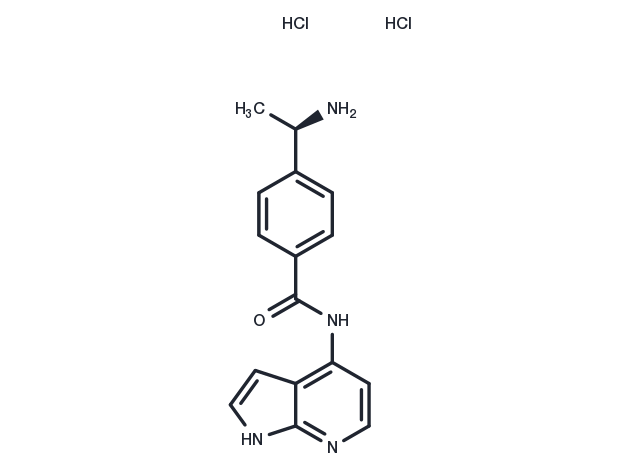store at low temperature,keep away from direct sunlight
Powder: -20°C for 3 years | In solvent: -80°C for 1 year

Y-33075 dihydrochloride is a selective inhibitor of ROCK(IC50 of 3.6 nM).

| Pack Size | Availability | Price/USD | Quantity |
|---|---|---|---|
| 2 mg | In stock | $ 38.00 | |
| 5 mg | In stock | $ 64.00 | |
| 10 mg | In stock | $ 109.00 | |
| 25 mg | In stock | $ 213.00 | |
| 50 mg | In stock | $ 379.00 | |
| 100 mg | In stock | $ 567.00 | |
| 1 mL * 10 mM (in DMSO) | In stock | $ 98.00 |



| Description | Y-33075 dihydrochloride is a selective inhibitor of ROCK(IC50 of 3.6 nM). |
| Targets&IC50 | PKC:420 nM, ROCK:3.6 nM, CaMK II:810 nM |
| In vitro | Y-33075 (Y-39983) is a potent inhibitor of ROCK(IC50 of 3.6 nM). Y-33075 also inhibits PKC and CaMKII more potently than Y-27632(IC50s of Y-27632 and Y-33075 for PKC are 9.0 μM and 0.42 μM, respectively), whereas the IC50s of Y-27632 and Y-33075 for CaMKII are 26 μM and 0.81 μM, respectively. The IC50s of Y-27632 and Y-33075 for PKC is 82 and 117 times those for ROCK, respectively, whereas the IC50s of Y-27632 and Y-33075 for CaMKII is 236 and 225 times those for ROCK, respectively[1]. Y-33075 (Y-39983, 10 μM) extends neurites in the retinal ganglion cells (RGCs) compared with those in RGCs treated without Y-39983[2]. Y-33075 (Y-39983, 1 μM) inhibits the contraction of rabbit ciliary artery segments evoked by histamine in Ca2+-free solutions[3]. |
| In vivo | Y-39983 (≥0.01%) significantly lowers intraocular pressure (IOP) at 2 hours after topical administration in rabbits. Y-39983 (0.05%)-treated eyes show significant reduction of IOP between 2 and 7 hours after topical administration in monkeys[1]. Y-39983 (100 μM) increases the regenerating axons of retinal ganglion cells (RGCs) in the eyes of the rats[2]. |
| Molecular Weight | 353.25 |
| Formula | C16H18Cl2N4O |
| CAS No. | 173897-44-4 |
store at low temperature,keep away from direct sunlight
Powder: -20°C for 3 years | In solvent: -80°C for 1 year
DMSO: 100 mg/mL (283.09 mM), Sonification is recommended.
H2O: 50 mg/mL (141.54 mM), Sonification is recommended.
You can also refer to dose conversion for different animals. More
bottom
Please see Inhibitor Handling Instructions for more frequently ask questions. Topics include: how to prepare stock solutions, how to store products, and cautions on cell-based assays & animal experiments, etc.
Y-33075 dihydrochloride 173897-44-4 Cell Cycle/Checkpoint Chromatin/Epigenetic Cytoskeletal Signaling Neuroscience Stem Cells CaMK ROCK PKC Y33075 dihydrochloride Y33075 Y 33075 Dihydrochloride ROK Rho-associated kinase Y-33075 Y-33075 Dihydrochloride Y33075 Dihydrochloride Inhibitor Rho-associated protein kinase Y 33075 dihydrochloride Rho-kinase inhibit Y 33075 inhibitor
